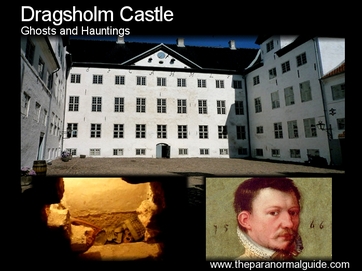
It is home to at least three ghosts, each with an interesting and sometimes tragic history. One such story was uncovered, literally, during renovations.
A Brief History of Dragsholm Castle
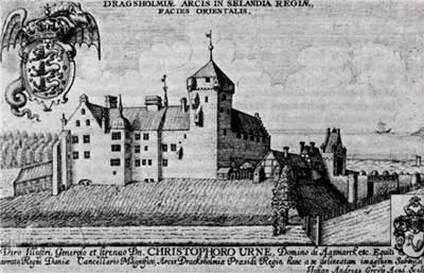 Early drawing of Dragsholm.
Early drawing of Dragsholm. Originally a palace, it was built for the Bishop of Roskilde. It remained thus until troubles were seen on the horizon and the palace was modified and, according to the times – modernised, into a fully fortified castle.
The foresight for the renovation, and the expenses, paid off when, through 1534 – 1536, what was known as the 'Counts War' raged throughout Denmark. There was an uprising against the king and other nobles, and with much of the peasantry incited to violence, many manors, palaces and a few castles were razed and ruined.
However Dragsholm was so strong, and so well fortified, it became the only castle in the entirety of Zealand to survive the war. However, at the end of the war there was a reformation in Denmark, and Dragsholm was taken from the church and passed to the crown, who had it converted into a prison for nobility.
The 4th Earl of Bothwell
 James Hepburn.
James Hepburn. The 4th Earl of Bothwell, James Hepburn, was the third husband of Mary, Queen of Scots. The marriage was a bit of a lurid affair at the time. Hepburn was seen as a troublesome noble within the Scottish court, who was later accused of 'intriguing against the crown'. He was imprisoned, even though the accuser was found to be quite mad – insane. He sat in his cell in Edinburgh Castle for a good time before he escaped and joined Queen Mary.
The two grew close, but five years later, in 1567, Hepburn was in trouble again – this time for murdering the Queens Consort Lord Darnley. For this he was soon acquitted, yet once again Hepburn would cause a division in the country, this time by marrying Queen Mary. The marriage lasted for a time, until there was an uprising, followed by violence, at which Hepburn fled, never to see his wife again. Queen Mary was deposed of the throne.
Hepburn left Scotland for Scandinavia, where he hoped to raise an army to win back Mary's throne. However, he was once again arrested, this time for holding the incorrect papers. Unfortunately for Hepburn he was escorted to Bergen, the native home of his abandoned fiancé Anna Throndsen. She sued Hepburn, who offered his ship as compensation (he had earlier, during their engagement, convinced Anna to sell all her possessions, and ask her parents for further money, so he could spend time in France, where he found his way into the royal court).
This would have been all fine and well, but once again, and finally, Hepburn found himself in trouble – the English Crown was looking for him, for the alleged murder of Mary, Queen of Scots’ second husband. He was sent to Dragsholm Castle and placed in a room, chained to a pillar. His conditions were so bad that he went insane, spending most of the days and nights walking in circles, too and fro, around the pillar. He actually wore a circular groove into the stone floor, from his repetitive motion.
He died in Dragsholm Castle on April 14, 1578. However, it does not stop there. His ghost is meant to be seen, well rather heard, about the formal courtyard of the Castle, sometimes accompanied by full horse and carriage. Maybe in death he finally got to serve a nice pompous existence in a ghostly court?
Darker History and Hauntings
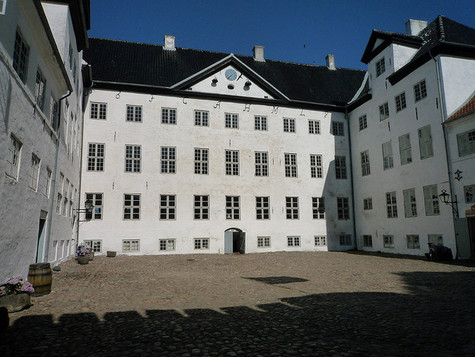 Dragsholm today.
Dragsholm today. The third ghost seems to also have an identity and a back story. It is not entirely sure when the events of this next story took place, but a good guess would be after the end of the 1600's, for it was during this time an attempt to blow up the castle was made, during yet another war.
With the castle largely in ruins, the King gave it to grocer Heinrich Muller to clear an outstanding debt. In 1694, the castle changed hands once again, this time ending up in the hands of a nobleman who fixed it up and changed the overall look to what you can see today.
Sometime after this point, the most tragic of tales in regards to the castle takes place. For years, decades, possibly even centuries, the spirit of a young woman, dressed in white, has been reported. She is seen walking the corridors, and at times crying. No one really knew who this young woman could be, until a story began to circulate.
She was the daughter of a noble and was set to be married into another family of nobility, in order to strengthen ties between the two names. She did not want this to happen as she was already in love with another. Her father knew of the relationship and allowed it to go unhindered on the promise that his daughter would do the right thing by the family when the time came.
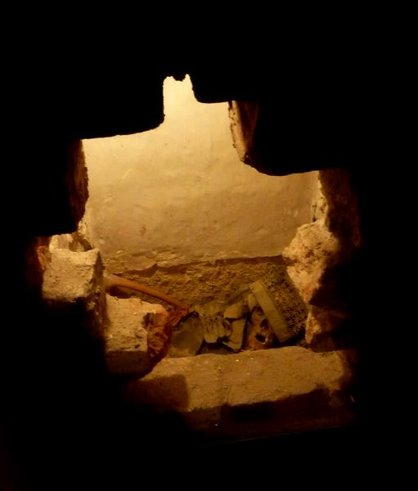 Skeleton in the wall cavity.
Skeleton in the wall cavity. When she began to show the signs of being pregnant, her father held a 'celebratory meal'. There she was drugged, after which her father had her imprisoned within the walls. Bricked and mortared in a tiny space, the young woman could be heard to scratch at the bricks and cry. Eventually she fell silent.
It is not certain whether her story was known before or after the following event, but still there seems to be some physical proof of her existence. Soon after World War 1, another restoration and renovation was under way. Workmen were breaking through an old brick wall when they made a gruesome discovery... a skeleton, shrouded in a white dress, was found within the wall cavity.
Some say the story of the girl, and the discovery of the skeleton, were a form of publicity stunt.
Others say that the skeleton is indeed several hundred years old, and is physical proof of the existence of the walled in girl.
I will leave it up to you to decide.
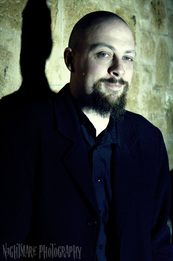




 RSS Feed
RSS Feed
